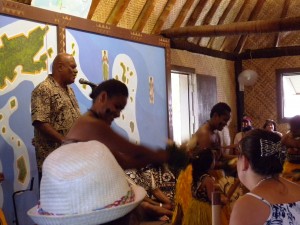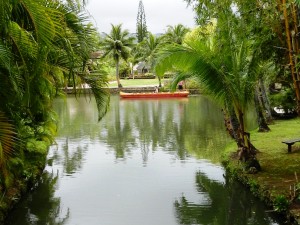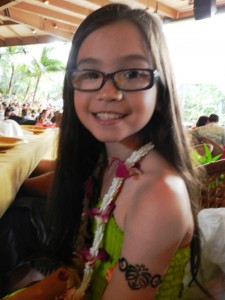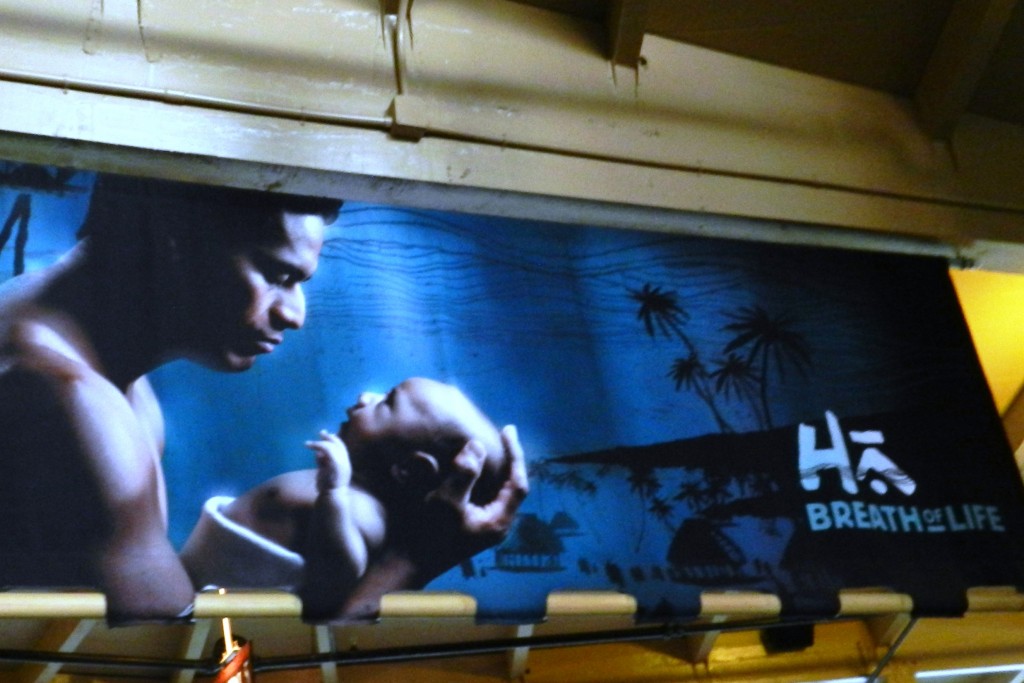» posted on Saturday, June 23rd, 2012 by Linda Lou Burton
Pass It Forward
 Linda Burton posting from Honolulu, Hawaii – “My 10-year-old son can recite our family genealogy for 17 generations back,” said our narrator. They’d found a place for Kayla and me on the back row of the jam-packed Fiji hut, and there we sat, bamboo sticks in hand, learning to chant and sing Fiji style. And, learning how to remember. The presentation at the Fiji settlement in the Polynesian Cultural Center was titled “History through Chants & Dance” and we’d just been taught how, as a group, to beat out rhythms, “one-two one-two-three” then “one-two-three-four” fast and slow, stop; then a call to us, “moo-oo” then our response “mai-ii” and repeat; somehow the roomful of us managed to do this together; and somehow, the feel of it began to stick in our memories. I know there’s a scientific explanation for what happens in the brain when rhythms and sounds take on a consistent pattern; but overall, it seemed to be the joy of it that took hold. Yet I was startled by that last remark. Seventeen generations?
Linda Burton posting from Honolulu, Hawaii – “My 10-year-old son can recite our family genealogy for 17 generations back,” said our narrator. They’d found a place for Kayla and me on the back row of the jam-packed Fiji hut, and there we sat, bamboo sticks in hand, learning to chant and sing Fiji style. And, learning how to remember. The presentation at the Fiji settlement in the Polynesian Cultural Center was titled “History through Chants & Dance” and we’d just been taught how, as a group, to beat out rhythms, “one-two one-two-three” then “one-two-three-four” fast and slow, stop; then a call to us, “moo-oo” then our response “mai-ii” and repeat; somehow the roomful of us managed to do this together; and somehow, the feel of it began to stick in our memories. I know there’s a scientific explanation for what happens in the brain when rhythms and sounds take on a consistent pattern; but overall, it seemed to be the joy of it that took hold. Yet I was startled by that last remark. Seventeen generations?
The narrator continued. “Family is very important in our culture, and children are taught from the beginning about their ancestors. My 6-year-old son can do the recitation for 10 generations back already.” He was explaining the value of learning by chanting; “we had no written language until recent times, so stories and our history were passed down orally.”
 Family history. Genealogy. Important in Polynesian culture; important to the LDS church. The Polynesian Cultural Center was built in 1963 by missionaries of The Church of Jesus Christ of Latter-day Saints; and about 80% of the workers and performers there today are students
Family history. Genealogy. Important in Polynesian culture; important to the LDS church. The Polynesian Cultural Center was built in 1963 by missionaries of The Church of Jesus Christ of Latter-day Saints; and about 80% of the workers and performers there today are students at the nearby branch of Brigham Young University. Most are from Polynesian countries but not all; our canoe “driver” later on was from Kansas. Rated the top paid tourist attraction in Hawaii, the Center is a non-profit organization, dedicated to preserving the cultural heritage of Polynesia while providing scholarships for hundreds of students. No tipping is allowed; no alcohol either; this is a family place with pleasant walkways and waterways meandering through 42 acres of Polynesian “settlements” representing Samoa, New Zealand (Aotearoa-Maori), Fiji, Hawaii, Tahiti, Tonga, and Easter Island (Rapa Nui).
at the nearby branch of Brigham Young University. Most are from Polynesian countries but not all; our canoe “driver” later on was from Kansas. Rated the top paid tourist attraction in Hawaii, the Center is a non-profit organization, dedicated to preserving the cultural heritage of Polynesia while providing scholarships for hundreds of students. No tipping is allowed; no alcohol either; this is a family place with pleasant walkways and waterways meandering through 42 acres of Polynesian “settlements” representing Samoa, New Zealand (Aotearoa-Maori), Fiji, Hawaii, Tahiti, Tonga, and Easter Island (Rapa Nui). 
There’s something educational in every spot; something entertaining too; bamboo raft rides and ukulele lessons, ancient games and spear tossing and coconut bread making; see the worship places and the community gathering huts; the warrior canoes and the Iosepa, a huge double-hulled canoe used by early Polynesians as they began to migrate. More to do than energy will allow; we walked and sat and walked and sat; we were gallantly canoed, carefully tattooed, and lavishly luau-ed, complete with Aloha greeting and orchid lei. There was music all day; music, and family; workers address visitors as “cousins.” We shared our luau table with Al and Debbie from Tennessee and their two sons and daughters-in-law; a big family table with friendly smiles, exchanging stories over roast pork and purple sweet potato and coconut cake, just like home.
luau table with Al and Debbie from Tennessee and their two sons and daughters-in-law; a big family table with friendly smiles, exchanging stories over roast pork and purple sweet potato and coconut cake, just like home.
The last family touch at 7:45, to the beating of the drums. We’re in the huge Pacific Theater now; the sky behind the mountain backdrop of the stage is navy blue; we’re so tired we’re close to sleep. Something white drops from the top of the curving roof above, flutters in the breeze; it’s a flowing screen, the backdrop for the story, HA, the Breath of Life. We see the couple’s escape from the volcano’s fire, what happens next? The screen drops away and people appear on the grassy stage; the tale is told. “Mesmerizing” is an overused word, but it’s the only word that fits; for the next ninety minutes we are caught up in the pageantry, the colors and sounds, the emotion of Mana’s life. A baby is born, the village rejoices. Father teaches son, son becomes a man. Life’s experiences shape character, the son becomes a father. And life continues, generation after generation. 
Our bus is waiting; we hold hands across the parking lot. Granddaughter Kayla curls up on the back seat; our driver dims the lights so we can nap on the hour-long ride to our hotel. Through the dark, I see the waves washing across the white-sand beach.
Seventeen generations? Chanted in the heart? Now, that is something.
About the Polynesian Cultural Center, 55-370 Kamehameha Highway, Laie, Hawaii 96762
